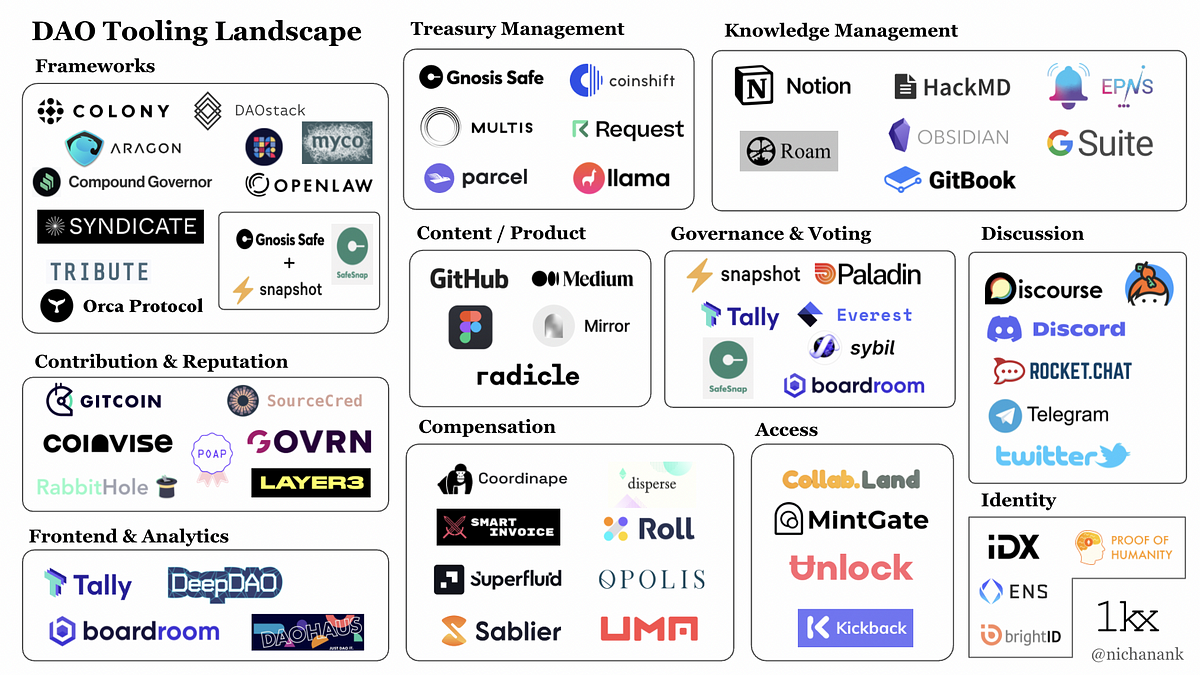

DAO Operations is a budding crypto vertical that remains underserved. With over 1,000 Snapshot spaces, 700k governance token holders, and over $10B in DAO treasury, there is a huge opportunity to create value in all operational arms of internet-native organisations.
The internet was the enabler of large-scale human coordination. DAO tools — built on web3 — now give us the ability to design and manage incentives to maintain positive-sum relationships between stakeholders, keeping them aligned on shared goals as the product or community grows.
Compared to the Cambrian explosion of “money legos” that has grown DeFi from $7B to $90B in the past year, the ecosystem of “organisation legos” is still in its infancy.
DAO Tooling Landscape — September 2021
Whether a DAO is spun up to build products (yearn, Sushi), to invest (The LAO, MetaCartel Ventures), to collect NFTs (FlamingoDAO, PleasrDAO), or to provide services (RaidGuild, LexDAO), all are susceptible to the same high-level challenges as they grow:
Because contributions to DAOs can come from anywhere, tools that qualify and quantify different types of contributions (e.g. bounties, DAO-specific metrics) can be used to create a shared understanding of priorities of how one can expect to be rewarded for different levels of participation. In addition to monetary compensation, DAOs can leverage reputation-building tools to motivate value-aligned participants to take on more ownership and grow with the DAO.
Decentralisation should not come at the expense of efficiency in the long run. Progressive decentralisation enables an initial team to search for product market fit on its way toward credible neutrality. We will explore examples of DAOs doing this through constrained delegation and working groups, as well as the tools that provide additional layers of checks and balances that hold executors accountable to token holders.
Voting tools help individuals voice their opinions, fund initiatives they care about, and empower representatives they trust to execute in a ways align with their views. Crucial to these decisions will be information that is relevant and accessible. Analytics tools and data aggregators play an important role in making DAOs human-readable, surfacing meaningful insights from raw on-chain and off-chain data.
In this article I explore these questions through the lens of organization design and the growing suite of web3-native tools that aims to address them. After exploring each category— contribution management, compensation, decision making, treasury, analytics, and DAO frameworks — we arrive at a snapshot of the ecosystem of organisation legos available today which, though multitudes richer than it was a year ago, can only hint at what’s to come.
At a certain headcount, what may start as a monolithic group chat organically breaks into working groups or functional committees in which members take on ownership of a given milestone.
The names and details of these groups vary across DAOs, but we can roughly group them by their operational functions.
To balance efficiency with decentralisation, DAOs have adopted patterns of distributed authority and constrained delegation in which token holders empower groups of active contributors with executive decision-making authority within a discrete domain.
Constrained delegation allows individuals with the expertise and intimate contextual knowledge to perform their jobs autonomously, while still being held accountable to the DAO. Working group leaders are often nominated or elected, and can be voted out by the community.
Examples of functional committees in yearn (“yTeams”), Nexus Mutual (“Hubs”), and Index Coop (“Working Groups”), respectively.